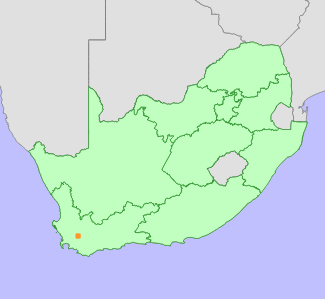|
Scientific Name | Drosanthemum hallii L.Bolus |
Higher Classification | Dicotyledons |
Family | AIZOACEAE |
National Status |
Status and Criteria | Endangered B1ab(ii,iii,iv,v) |
Assessment Date | 2006/08/07 |
Assessor(s) | C. Klak & D. Raimondo |
Justification | EOO<657 km², three known locations are declining due to vineyard expansion and alien plant invasion. |
Distribution |
Endemism | South African endemic |
Provincial distribution | Western Cape |
Range | Worcester. |
Habitat and Ecology |
Major system | Terrestrial |
Major habitats | Robertson Karoo, Breede Shale Renosterveld, Breede Alluvium Fynbos |
Description | Stony slopes on shale-sandstone transition soils. |
Threats |
| Highly threatened by agricultural activities especially vineyard farming. There has been a past loss of habitat to Brandvlei dam. Mining is a severe ongoing threat while competition with invasive alien species is a slight ongoing threat. |
Population |
Population trend | Decreasing |
Assessment History |
Taxon assessed |
Status and Criteria |
Citation/Red List version | | Drosanthemum hallii L.Bolus | EN B1ab(ii,iii,iv,v) | Raimondo et al. (2009) | | Drosanthemum hallii L.Bolus | Rare | Hilton-Taylor (1996) | |
Bibliography |
Goldblatt, P. and Manning, J.C. 2000. Cape Plants: A conspectus of the Cape Flora of South Africa. Strelitzia 9. National Botanical Institute, Cape Town.
Hilton-Taylor, C. 1996. Red data list of southern African plants. Strelitzia 4. South African National Botanical Institute, Pretoria.
Raimondo, D., von Staden, L., Foden, W., Victor, J.E., Helme, N.A., Turner, R.C., Kamundi, D.A. and Manyama, P.A. 2009. Red List of South African Plants. Strelitzia 25. South African National Biodiversity Institute, Pretoria.
|
Citation |
| Klak, C. & Raimondo, D. 2006. Drosanthemum hallii L.Bolus. National Assessment: Red List of South African Plants version 2024.1. Accessed on 2025/12/23 |
 Comment on this assessment
Comment on this assessment


